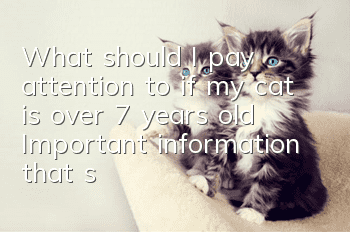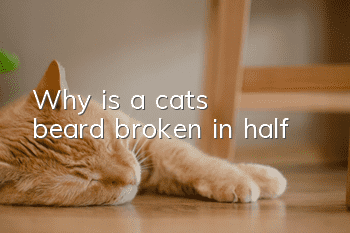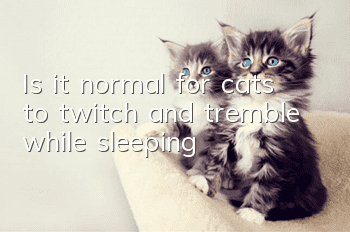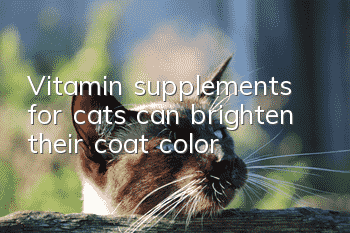What should I pay attention to if my cat is over 7 years old? Important information that scrappers must know!

If your cat is over 7 years old, it means that the cat has entered the old age stage. Just like the parts of a car will be damaged and eliminated, the body organs of old cats are also gradually changing or "aging". Generally speaking, there are 7 major categories of diseases that are more likely to occur in elderly cats, so cat owners should pay special attention to them!
1. Kidney failure
One of the biggest killers of cats is kidney failure (CKD), sometimes called chronic kidney disease or chronic kidney injury. Basically meaning that 75% of kidney function is ineffective and non-functional.
Kidney failure is a common disease in old cats, regardless of gender or breed. Symptoms include: drinking a lot of water, frequent urination, huge clumping of cat litter, bad breath, lethargy, weight loss, and a tendency to hide. Severe symptoms include not eating, vomiting, and even convulsions. ,die.
Since cats are carnivores, the incidence of kidney failure is much higher than that of dogs, and they should be given professionally formulated cat food under the guidance of a veterinarian.
Many brands of cat food now have formulas for senior cats. It is recommended that cats should switch to senior cat food when they are 7 years old.
2. Dental calculus and gingivitis
When dental calculus and gingivitis occur, salivation is the most common first, food intake gradually decreases, people want to eat but do not open their mouth, gradually lose weight, and have obvious bad breath.
In order to give their cats better so-called food, some parents usually make their own cat rice. Cat rice is mostly soft food, such as minced meat mixed with nutritional powder, canned food, raw beef, etc. However, when cats reach a certain age, they need Eat dry food to help clean your teeth. Long-term eating of dry food will help the health of your gums and delay the occurrence of dental calculus.
3. Obesity
Obesity is the most common nutritional disease in elderly cats. Maintaining an appropriate weight is the key to avoiding obesity. It is recommended that obese cats undergo regular physical examinations. Feline indicators can reveal many potential risks.
Nowadays, many brands of cat food have also launched weight-control cat food. If your cat is obese, it is recommended to switch to weight-control food. Since cats’ eating habits have become quite fixed in their old age, some cats may not necessarily eat weight-control cat food when they reach old age. Therefore, it is also a good choice to give small amounts of highly palatable food regularly.
IV. Hyperthyroidism
Loss of appetite and weight loss are general symptoms of hypothyroidism. You can feed your cat with high-energy, palatable food. At the same time, you should avoid long-term loss of appetite in cats (especially fat cats) to prevent the occurrence of fatty liver.
Cats usually like to comb their quilts with their tonguesDue to the barbs on the tongue, it is easy to swallow the hair into the body, causing feces to accumulate in the colon. As a cat owner, you should pay attention to some changes in aging cats, especially when cats are over 6 years old.
5. Diabetes
Diabetes mellitus (DM) is also one of the main killers of cats. Obese cats are at greater risk of developing diabetes. Diabetes refers to the inability of the pancreas to secrete sufficient amounts of insulin (type I DM) or the presence of resistance to insulin (type II DM). Insulin is a natural hormone that drives sugar (blood sugar) into cells. As cells are starved of glucose, the body produces more and more glucose, leading to hyperglycemia (i.e., high blood sugar) and many of the clinical symptoms of diabetes.
Symptoms include: drinking a lot of water and urinating a lot, large clumps of cat litter; due to muscle atrophy (especially in the spine or back); loss of appetite or ravenous bowels; lethargy or weakness; vomiting; bad breath (acetone-smelling breath); abnormal walking (e.g., Walk close to the ground)
Treatment for diabetes is expensive and requires subcutaneous injections of insulin twice a day. Dietary changes (switching to a high-animal protein, low-carbohydrate diet), frequent blood sugar monitoring, and frequent veterinary visits are also required. With supportive care and long-term management, some cats can survive well; however, once diabetic complications occur (such as diabetic ketoacidosis, hyperosmolaremia, hyperglycemic syndrome), they may be life-threatening.
6. Heart disease
Heart disease is a very troublesome disease. Some pedigree cats also have hereditary heart disease in their genes. Dogs can tell they have heart disease by hearing a heart murmur, but cats usually don't have a heart murmur, so diagnosis can be difficult. An estimated 50% of cats with heart disease have no auscultable heart murmur.
Symptoms of heart disease include: heart murmur; abnormal heart rhythm; rapid heartbeat; fainting; increased breathing rate; difficulty breathing; blue-stained gums; mouth breathing; acute, sudden paralysis (such as typical hind limb paralysis); coldness, pain of hind limbs; sudden pain; sudden lameness; sudden death.
We still recommend that you feed your elderly cats senior cat food. Some high-quality senior cat food will have a certain heart-protecting function.
7. Cancer
The most common cancer in cats is gastrointestinal cancer, usually caused by lymphosarcoma. Symptoms include: weight loss; skipping meals; vomiting; diarrhea; difficulty breathing; bloating; weakness; lethargy; hiding; fever.
If the above symptoms occur, seek medical attention as soon as possible to find out the cause. The editor still recommends that you must pay attention to your usual cat-raising habits. Elderly cats need high-quality protein, which is easy to digest. In addition, cats mustIn addition to normal cat food, lysine, taurine, folic acid and other nutrients need to be supplemented. With good daily care, your cat will still be healthy, cute and adorable by your side in old age.
- Why do cats vomit yellow water and become depressed?
- What causes urinary incontinence in kittens?
- How to prevent nasal congestion in cats
- Do Himalayan cats shed a lot?
- Can cats eat potassium iodide?
- How long does it take to keep a domestic cat to rule out rabies?
- Can cats eat grapefruit pulp?
- Symptoms of cat ear mites
- Garfield (exotic shorthair cat) racial genetic disease
- What should I do if my cat keeps vomiting?



